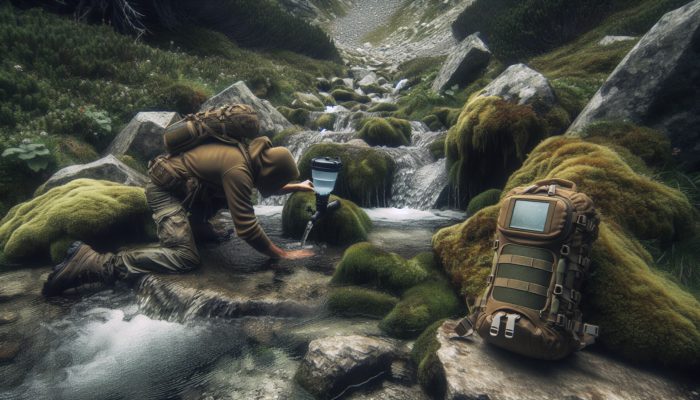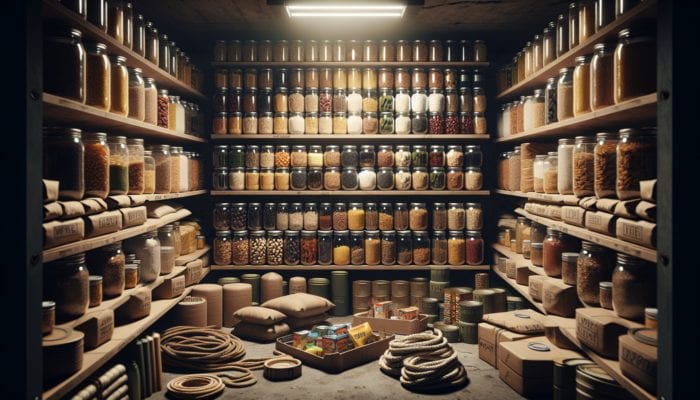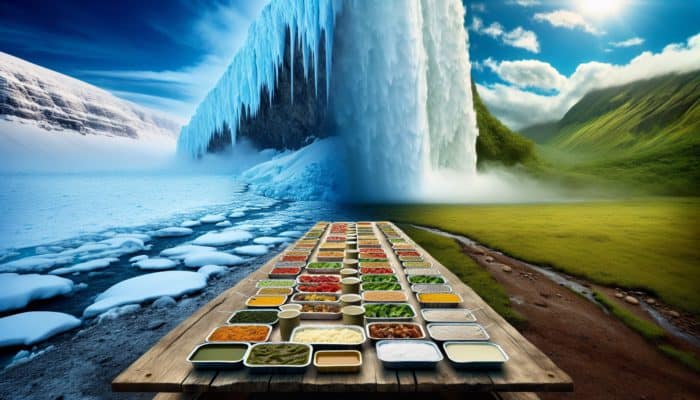Essential Water Filtration Systems for Survivalists: Guarantee Safe Access to Clean Drinking Water
Securing access to clean water is among the most critical prepper supplies, standing as a fundamental pillar for survival. This necessity renders water filtration systems vital components within any survivalist's toolkit. Whether confronted with natural disasters, venturing into untouched wilderness, or preparing for unpredictable future events, having the capability to purify water effectively is essential for sustaining hydration and overall health. Let us explore the diverse range of filtration systems available, ensuring that you remain hydrated and safeguarded, irrespective of the circumstances you may encounter.
Portable Water Filters: Your Key Solution for Safe Hydration on the Move

Imagine a scenario where your access to clean water is abruptly interrupted. In such instances, portable filters provide an exceptionally lightweight and efficient means of purifying water while you are on the run. These compact tools are available in a variety of designs, from straw-style filters to pumps capable of filtering large volumes rapidly. For example, the LifeStraw is ingeniously designed for individual use, permitting you to safely drink directly from dubious water sources without the worry of contamination. Given the ongoing impacts of climate change and increasingly erratic weather patterns, integrating portable filters into your emergency supplies is becoming ever more essential for your safety and well-being.
Moreover, numerous portable filters are adept at eliminating bacteria, protozoa, and, in certain cases, viruses, ensuring that the water you consume is secure and devoid of harmful pathogens. Their user-friendly design makes them not only suitable for survivalists but also for outdoor enthusiasts engaging in hiking or camping excursions globally. In regions like the Amazon rainforest or the Australian Outback, where access to potable water is scarce, possessing a portable filtration system can be the critical determinant between survival and peril.
Gravity Water Filters: Dependable Solutions for Larger Groups During Emergencies
As you prepare for emergencies, gravity filters stand out as a robust choice, particularly advantageous for families or larger collectives. These systems function based purely on the force of gravity, requiring no electrical power to operate, making them ideal for prolonged outages or remote environments. A well-known model, the Berkey gravity filter, is capable of purifying significant volumes of water while efficiently removing harmful contaminants.
Gravity filters prove particularly beneficial in areas frequently affected by natural disasters, such as hurricane-prone regions in the Caribbean or earthquake-prone zones in Asia. They can process multiple gallons of water simultaneously, making them suitable for emergency scenarios. It is crucial to understand the local conditions where you plan to use them; for instance, water sourced from sediment-laden rivers may necessitate pre-filtration to ensure optimal performance and efficiency of the filtration system.
Chemical Water Treatments: Compact and Efficient Methods for Water Purification
For survivalists seeking lightweight and space-efficient alternatives, chemical treatments offer a practical approach to water purification. Typically available in tablet or liquid drop forms, these treatments can eradicate harmful pathogens within minutes. For example, chlorine dioxide tablets are effective against a wide variety of bacteria and viruses, making them an excellent addition to your emergency preparedness kit.
Chemical treatments are particularly beneficial when you are travelling or unable to carry bulky filtration systems. Picture hiking through the tundra in Alaska or navigating the dense forests of Canada; having chemical treatments ensures that you can purify water from streams or lakes without the need for extensive equipment. However, it is essential to comprehend the correct usage of these treatments; incorrect dosages can result in ineffective purification, jeopardising your health and safety.
Strategic Food Storage Solutions: Essential Supplies for Long-Term Survival

Food shortages during times of crisis can lead to severe consequences, underscoring the importance of effective food storage strategies for long-term survival. Knowing how to store food correctly ensures that you can meet your nutritional requirements even in challenging situations. Here’s an in-depth exploration of the types of food storage options that every survivalist should contemplate.
Freeze-Dried Meals: Nutritious, Lightweight, and Long-Lasting Options for Emergency Preparedness
Freeze-dried meals have garnered immense popularity within the survivalist community due to their lightweight and long-lasting attributes. These meals maintain a substantial portion of their nutritional value and can endure up to 25 years when stored appropriately. They are easily rehydrated with hot water, making them ideal for quick nourishment during emergencies.
For adventurers traversing challenging terrains, such as the Himalayas or the Sahara Desert, freeze-dried meals provide the advantage of easy transport and rapid preparation. Renowned brands like Mountain House and Backpacker's Pantry offer a diverse array of options, ranging from hearty stews to breakfast staples. The convenience of these meals, paired with their extended shelf life, solidifies their reputation as a top choice for anyone serious about meal planning and preparation.
Canned Goods: A Reliable Nutrition Source for Emergency Situations
Canned goods represent a trustworthy source of nutrition capable of withstanding the test of time. These non-perishable items encompass a wide variety of options, from fruits and vegetables to meats and soups, simplifying the maintenance of a balanced diet during emergencies. Their versatility allows for incorporation into numerous recipes, ensuring that you won’t tire of your food options.
Careful consideration is necessary when storing canned goods, particularly regarding temperature and humidity. Optimal storage conditions can significantly extend their shelf life, which is especially advantageous in diverse climates, from humid tropics to arid deserts. Countries like Italy and Mexico, known for their rich traditions in canned goods, exemplify how food preservation can be both practical and delightful, enhancing the culinary experience even in challenging times.
Meals Ready to Eat (MREs): Quick and Convenient Nutrition for Any Survival Scenario

Meals Ready to Eat (MREs) are another invaluable asset in your food storage strategy. Originally developed for military applications, these meals are self-contained and can be consumed without cooking, making them indispensable for emergencies. With a shelf life ranging from 12 to 24 months, MREs provide a quick and reliable source of complete nutrition, particularly in situations where cooking facilities may not be accessible.
The appeal of MREs extends beyond survivalists; campers, hikers, and travellers in remote locations—such as the Arctic tundra or the Amazon basin—benefit from the convenience these meals offer. Although the variety may not rival that of fresh food, the practicality of MREs ensures that you remain energised and ready to tackle whatever challenges arise.
Dehydrated Foods: Maximising Nutritional Storage and Portability for Emergencies
Dehydrated foods provide an excellent option for survivalists aiming to maximise their food storage capabilities. With low moisture content and an extended shelf life, these foods are lightweight, nutrient-dense, and require only water for rehydration. Common examples include fruits, vegetables, and complete meals.
In regions where fresh produce is hard to come by, such as deserts or high-altitude areas, dehydrated foods become a vital resource. They can be easily stored in vacuum-sealed bags, allowing you to pack considerable nutritional resources without taking up much space. Mastering the proper techniques for rehydrating these foods is essential; improper methods can lead to substandard meals that fail to effectively replenish energy and nourishment.
Vacuum-Sealed Foods: Preserving Freshness and Flavour for Long-Term Storage
Vacuum sealing is an effective method for preserving the freshness and flavour of various foods. This technique eliminates air from packaging, significantly slowing spoilage and extending shelf life to several years. From meats to grains, vacuum-sealed foods can provide a diverse diet during emergencies.
Vacuum-sealed items are especially advantageous in environments where food preservation faces challenges from external factors, such as tropical climates where high humidity can rapidly degrade food quality. By investing in a reliable vacuum sealer and mastering proper storage techniques, survivalists can accumulate essential supplies that maintain their deliciousness and nutritional value over time, ensuring that meals remain enjoyable even in dire circumstances.
Emergency Communication Devices: Essential Tools for Survivalists
In times of disaster, maintaining communication is critical for ensuring your safety and coordinating with others effectively. Emergency communication devices can mean the difference between isolation and successful rescue or collaboration. Here’s a thorough examination of the various communication tools every survivalist should incorporate into their emergency preparedness toolkit.
Two-Way Radios: Stay Connected in Critical Moments
Two-way radios are indispensable for facilitating communication when traditional networks fail. These devices enable short-range communication, allowing users to coordinate efforts during emergencies or natural disasters effectively. Models such as the Midland GX Series are highly esteemed within the survivalist community for their durability and impressive range.
In scenarios like wildfires in California or hurricanes in Florida, possessing two-way radios can be lifesaving. They enable family members to stay in contact without relying on cellular towers, which may become overloaded or compromised during crises. Understanding the frequency bands and range of your radios is crucial; this knowledge ensures effective communication, whether you find yourself in a crowded urban environment or the remote wilderness.
Satellite Phones: Reliable Communication Solutions in Isolated Areas
For those venturing into particularly remote regions, satellite phones offer a dependable means of communication, regardless of your location. Unlike standard mobile phones, satellite phones can connect even in the most isolated areas, making them essential for both survivalists and adventurers alike. Devices from brands like Iridium and Inmarsat enable users to make calls from virtually any corner of the globe.
The versatility of satellite phones extends to a variety of scenarios, including expeditions in the Arctic, sea voyages across the Pacific, or emergencies during international travel. As global positioning systems become increasingly interconnected, understanding how to utilise satellite phones effectively can significantly enhance your preparedness, ensuring that you are never truly off the grid.
Hand-Crank Radios: Stay Informed Without Dependence on Power
Hand-crank radios are powerful tools for staying informed during emergencies. These devices not only receive emergency broadcasts but can also charge other devices, making them invaluable when power sources are scarce. Models like the Eton FRX Series are designed to withstand tough conditions and provide critical information during crises.
In regions prone to natural disasters, such as tornado areas in the United States or flood-prone locales in Southeast Asia, having a hand-crank radio can mean the difference between chaos and a well-organised response. By keeping one of these devices in your emergency kit, you ensure access to real-time updates, enabling you to make informed decisions during critical situations.
Emergency Whistles: Simple Yet Effective Signaling Tools
In situations where electronic devices may fail, emergency whistles provide a straightforward yet effective method for signalling for assistance. These small, lightweight tools can be heard over great distances, making them ideal for close-range rescue scenarios. Their ease of use means that anyone can utilise them without the need for specialised training or equipment.
Picture yourself lost in the dense forests of the Amazon or the expansive wilderness of Canada; possessing an emergency whistle can attract the attention of rescuers without draining batteries or risking signal loss. For effective communication, it’s essential to convey different patterns of use; typically, three short blasts indicate distress and signal for help.
Signal Flares: Critical for Attracting Rescuers During Emergencies
Signal flares are a vital component of any emergency communication strategy, particularly in remote or marine environments. Visible from long distances, they alert rescuers and draw attention, which is essential during both day and night emergencies. Flares can be either handheld or launched, providing flexibility for various scenarios.
For instance, sailors navigating the open ocean or individuals stranded in mountainous terrains can significantly benefit from signal flares. However, it is crucial to understand local regulations regarding flare usage, as some regions may impose restrictions. Additionally, knowing how to store and handle flares properly ensures they remain effective and ready for use when needed most.
First Aid Kits: Essential Medical Supplies for Emergency Situations
In emergencies, immediate access to medical supplies can be lifesaving. Comprehensive first aid kits can assist in addressing minor injuries and serious medical situations, ensuring that you possess the necessary tools to respond effectively. Here’s how to construct a robust first aid kit tailored for various needs and scenarios.
Basic First Aid Kits: Essential Supplies for Immediate Care
Every survivalist should maintain a basic first aid kit stocked with vital items such as bandages, antiseptics, and pain relievers. These kits provide the essential supplies needed to treat minor injuries and common ailments that may arise during emergencies. The Red Cross and other organisations offer guidelines on how to create effective basic kits.
In areas prone to accidents—like rural regions with high outdoor activity or urban environments with dense populations—having a basic first aid kit is crucial. These kits can be customised to include specific items relevant to your environment, such as insect bite cream for tropical climates or burn ointment for areas with high fire risks. Tailoring your kit ensures it meets your needs effectively and efficiently.
Advanced First Aid Kits: Comprehensive Care for Severe Injuries
Building upon the essentials, advanced first aid kits contain more comprehensive supplies designed for treating serious injuries. These kits often include items such as splints, advanced wound dressings, and trauma shears, providing a higher level of care when it is most needed. Knowing how to utilise these supplies effectively is crucial for anyone serious about preparedness.
Advanced kits are particularly vital in locations where access to healthcare is limited or during large-scale emergencies. Whether faced with natural disasters like earthquakes or man-made crises, having an advanced first aid kit can save lives. Customising the contents to your specific environment, including medications and treatments for prevalent health issues, can further enhance their effectiveness and readiness.
Trauma Kits: Preparing for Life-Threatening Medical Situations
For those preparing for severe injuries, trauma kits are indispensable. These kits are specifically designed to address life-threatening conditions and include critical items such as tourniquets, chest seals, and hemostatic dressings. In high-risk environments, like construction sites or remote expeditions, having a trauma kit can be the key to survival and effective medical response.
Understanding how and when to use these supplies is essential. In scenarios such as car accidents or outdoor injuries, a well-stocked trauma kit provides the necessary tools to stabilise a patient until professional help arrives. Training in first aid and trauma response can significantly enhance the effectiveness of your preparedness efforts, ensuring you are ready to act when it matters most.
Alternative Power Sources: Indispensable Backup Supplies for Survivalists
When the power goes out, access to alternative power sources can keep you connected and secure. Understanding the various options available allows you to be adequately prepared for extended outages, making it vital to explore the different power sources you can utilise during emergencies.
Solar Chargers: Eco-Friendly Solutions for Charging Your Devices
Utilising the sun's energy, solar chargers provide an eco-friendly approach to charging essential devices. These portable chargers can prove invaluable during long-term outages, allowing you to keep your phones, radios, and other electronics operational. Many models are lightweight and built for durability, making them ideal for both outdoor adventures and emergency situations.
In regions with ample sunlight, such as the deserts of the American Southwest or the beaches of Australia, solar chargers can serve as a sustainable power source. Understanding how to position your solar panels for optimal sunlight collection is crucial; proper angling can significantly enhance charging efficiency, ensuring that you always have power when you need it most.
Portable Generators: Reliable Power for Multiple Devices and Appliances
When you require dependable electricity to power multiple devices and appliances, portable generators are the ideal solution. These machines provide robust power during extended outages, enabling critical equipment such as refrigeration and medical devices to remain operational. Brands like Honda and Generac offer a variety of models specifically designed for portability and efficiency.
However, the use of portable generators comes with the responsibility of safe operation. Understanding fuel types, maintenance, and proper ventilation is critical to prevent accidents and ensure smooth operation. In urban settings or regions susceptible to severe weather, these generators can serve as a lifeline, keeping your family comfortable and secure during challenging times.
Battery Banks: Compact Energy Storage Solutions for Emergencies
Battery banks are compact solutions for storing energy and charging devices. These versatile power sources are ideal for emergencies where access to electricity is limited. With the capability to charge multiple devices simultaneously, battery banks become essential for maintaining communication and access to information during crises.
In remote scenarios, such as camping in the wilderness or travelling in areas with unreliable infrastructure, having a battery bank ensures your essential devices remain operational. Understanding the capacity and output of your battery bank is vital, as it determines how many devices you can power and for how long, ensuring you stay connected and informed during critical situations.
Wind Turbines: Harnessing Natural Energy for Sustainable Power Solutions
Wind turbines present an exciting, eco-friendly option for generating electricity, particularly in regions with consistent wind patterns. These systems can provide a sustainable power source during outages, enabling survivalists to effectively harness natural energy. Understanding the local wind conditions where you reside is crucial for maximising the effectiveness of wind turbines and ensuring they meet your energy needs.
In coastal areas or open plains, investing in a wind turbine can greatly enhance your energy independence. Along with proper installation, regular maintenance is necessary to ensure optimal performance. For those committed to off-grid living, combining wind and solar power solutions can create a robust energy network tailored to meet your specific requirements.
Fuel Cells: Portable and Reliable Power for Emergency Situations
Fuel cells convert chemical energy into electrical power, offering a reliable and portable solution for essential devices during emergencies. These systems are capable of providing consistent power outputs, making them suitable for various applications, from home use to portable setups for camping and travel.
As fuel cells become increasingly accessible, understanding their capabilities and limitations is crucial for effective use. They can be particularly beneficial in areas with limited access to conventional power sources, allowing for flexibility in powering devices when traditional methods are unavailable. Whether you're exploring remote territories or preparing for potential disruptions, fuel cells can significantly enhance your preparedness strategy.
Crucial Shelter and Warmth Equipment: Your Key to Outdoor Survival
In emergencies, adequate shelter and warmth are essential for survival. Whether you are facing extreme weather conditions or the uncertainties of a disaster scenario, the right supplies can help protect you and your loved ones. Here’s a detailed look at the shelter and warmth solutions every survivalist should consider for optimal protection.
Tents: Portable Protection Against Harsh Weather Conditions
Tents serve as portable and durable shelters, crucial for protection against the elements during emergencies or evacuations. When selecting a tent, consider factors such as size, weight, and weather-resistance features. Brands like REI and MSR provide a range of models tailored to different environments, ensuring you have the right option for your specific requirements.
In scenarios where evacuation is necessary, having a reliable tent can offer a secure place to rest, whether you find yourself in a temporary camp or navigating the aftermath of a natural disaster. Understanding proper tent setup and maintenance is essential to enhance your experience; ensuring waterproofing and structural integrity can significantly impact your comfort and safety.
Insulated Sleeping Bags: Essential Protection Against Cold Weather
An insulated sleeping bag is critical for retaining body heat in frigid conditions, making it a vital component of your preparedness kit. These bags come in various styles, ranging from lightweight models designed for summer camping to heavy-duty options suitable for winter conditions. Knowing how to select the appropriate sleeping bag based on temperature ratings ensures you remain warm during emergencies.
Imagine facing a sudden winter storm in the mountains or finding yourself in an unheated shelter; having an insulated sleeping bag can protect you from hypothermia and other cold-related issues. Additionally, selecting a sleeping bag that compresses easily allows for efficient storage and transport, which is crucial for those on the go.
Emergency Blankets: Compact Solutions for Effective Heat Retention
Emergency blankets, often referred to as space blankets, are lightweight and compact solutions for conserving body heat. Made from reflective materials, these blankets drastically reduce heat loss, making them invaluable during emergencies. Their small size allows them to fit into pockets or emergency kits with ease, ensuring they are readily available when needed most.
In high-stress situations, such as after a natural disaster or during an unexpected outdoor adventure, having an emergency blanket can provide immediate warmth and comfort. Their versatility extends beyond personal use; they can also be used to cover injured individuals or serve as makeshift shelters. Understanding how to utilise emergency blankets effectively can greatly improve your chances of staying safe and warm in critical situations.
Lighting and Illumination: Essential Tools for Preppers
When the power goes out, reliable lighting sources become crucial for maintaining safety and morale. There’s a wide array of lighting options available for survivalists, ensuring you can navigate your surroundings and remain informed during emergencies. Let’s examine the various illumination tools that can enhance your preparedness strategy.
Headlamps: Hands-Free Lighting Solutions for Every Situation
Headlamps provide hands-free lighting, essential for navigating in the dark during emergencies or power outages. These compact devices comfortably fit on your head, allowing you to engage in various activities while keeping both hands free. Brands like Petzl and Black Diamond offer numerous options, ensuring there’s a headlamp suitable for every need.
Whether you are searching for supplies in a dimly lit area or tending to injuries in the dark, a headlamp can provide essential illumination. Understanding the battery life and brightness settings can help you select the right model, ensuring you remain prepared for different situations. In remote outdoor environments or during emergencies at home, headlamps can significantly enhance your mobility and safety.
Lanterns: Ambient Lighting for Larger Areas
For more expansive spaces, lanterns offer ambient light capable of illuminating rooms or outdoor areas, crucial for maintaining visibility and morale during crises. Lanterns come in various fuel types, including battery-operated, propane, and solar-powered models, making it easy to find one that meets your specific needs.
In situations like family gatherings during power outages, having a reliable lantern can create a sense of normalcy and comfort. Understanding the pros and cons of each fuel type is vital. For instance, solar-powered lanterns are eco-friendly but require sunlight for charging, while battery-operated models provide consistent light but depend on the battery's lifespan.
Glow Sticks: Chemical Lights for Emergency Applications
Glow sticks are chemical lights that require no batteries, making them useful for marking locations or providing light in emergencies. Their portability and ease of use make them a practical addition to your emergency kit, available in various colours and sizes for versatile applications.
Imagine being in a dark forest or cave after an unexpected power outage; having glow sticks can aid in safe navigation or signal your location to others. Furthermore, they can serve as mood lighting during stressful situations, helping to alleviate anxiety and maintain morale among those around you.
Solar-Powered Lights: Sustainable Illumination Solutions for Preparedness
Solar-powered lights are eco-friendly solutions that charge during the day and provide illumination at night. Ideal for long-term use in emergencies or off-grid situations, these lights offer a reliable light source without the need for batteries or fuel.
In regions with extended daylight hours, such as equatorial climates, solar-powered lights can be particularly effective. They can illuminate pathways, provide ambient light inside shelters, or serve as beacons during rescue operations. Understanding how to position and maintain solar-powered lights ensures they remain effective, maximising their utility during emergencies.
Personal Protection Supplies: Essential Tools for Ensuring Your Safety
When preparing for emergencies, personal protection becomes a critical aspect of your overall strategy. Having the right tools can help defend against threats while ensuring your safety in various situations. Let’s take a closer look at some of the personal protection supplies every survivalist should consider.
Multi-Tools: Versatile Solutions for Various Scenarios
Multi-tools are versatile devices that combine multiple functions into one compact format. Typically featuring items such as knives, pliers, screwdrivers, and can openers, these tools are essential for a wide range of scenarios. Renowned brands like Leatherman and Gerber offer reputable multi-tools designed for durability and functionality.
In emergencies, multi-tools can play a crucial role, whether you need to secure shelter, prepare food, or perform basic repairs. Understanding how to effectively utilise each function is essential; for instance, knowing how to use the knife safely can prevent accidents while preparing meals or cutting materials. By including a high-quality multi-tool in your emergency kit, you equip yourself with a reliable resource for diverse needs and situations.
Commonly Asked Questions: Your Essential Prepper Queries Addressed
What are the essential prepper supplies for beginners?
Basic prepper supplies for novices include water filtration systems, non-perishable food items, first aid kits, communication devices, and emergency lighting solutions. These essentials provide a solid foundation for effective preparedness.
How should I store my prepper supplies for optimal longevity?
Store prepper supplies in a cool, dry location, ensuring they are protected from direct sunlight. Utilise airtight containers for food items, and regularly check expiration dates to confirm that all items remain usable and safe for consumption.
How often should I refresh my emergency supplies?
Review and refresh your emergency supplies every six months to ensure they are current and effective. This practice guarantees that food and medications remain fresh and that you possess the necessary items to meet evolving needs and circumstances.
What is the best water filtration system for emergencies?
The best water filtration systems for emergencies are those that are portable, effective against a wide range of contaminants, and user-friendly. Portable filters and gravity filters are popular choices among survivalists due to their reliability and efficiency.
Can I prepare my emergency food supplies at home?
Yes, you can prepare your emergency food by dehydrating fruits and vegetables or canning meats and meals. Proper techniques are crucial to ensuring that your food remains safe and edible for an extended period.
What items should be included in a basic first aid kit?
A basic first aid kit should encompass items such as adhesive bandages, antiseptic wipes, gauze pads, medical tape, scissors, pain relievers, and a first aid manual. Tailor the kit to your specific needs and the environment in which you live.
What is the shelf life of freeze-dried meals?
Freeze-dried meals typically have a shelf life of 25 to 30 years when stored properly. Be sure to check individual packaging for specific expiration dates, as they may vary by brand and meal type.
How can I ensure my emergency communication devices work effectively?
Ensure that your emergency communication devices are charged, equipped with fresh batteries, and tested regularly to confirm optimal performance. Familiarising yourself with their operation and keeping them accessible in emergencies can enhance their effectiveness.
What types of personal protection gear should I have?
Personal protection gear can include multi-tools, self-defence items like pepper spray, tactical flashlights, and sturdy footwear. Choose items based on your environment and the potential threats you may face.
How can I prepare for extreme weather conditions?
To prepare for extreme weather, stock up on food, water, and emergency supplies tailored to your local climate. Investing in proper shelter and clothing capable of withstanding specific conditions, such as heat or cold, is crucial for maintaining safety and survival.
Explore our world on X!
The post Top Prepper Supplies: Essential Gear for Preparedness appeared first on Survival Bite.
The Article Essential Gear for Preparedness: Top Prepper Supplies Was Found On https://limitsofstrategy.com

